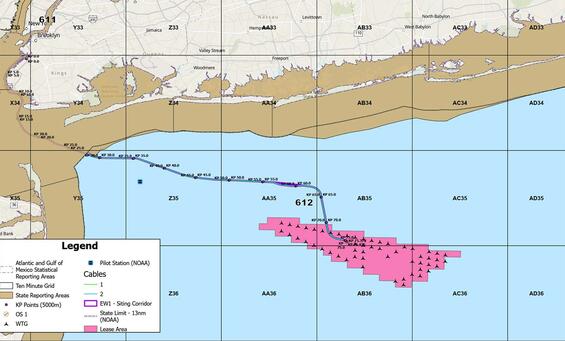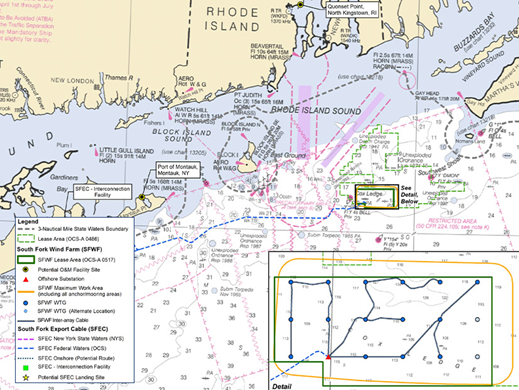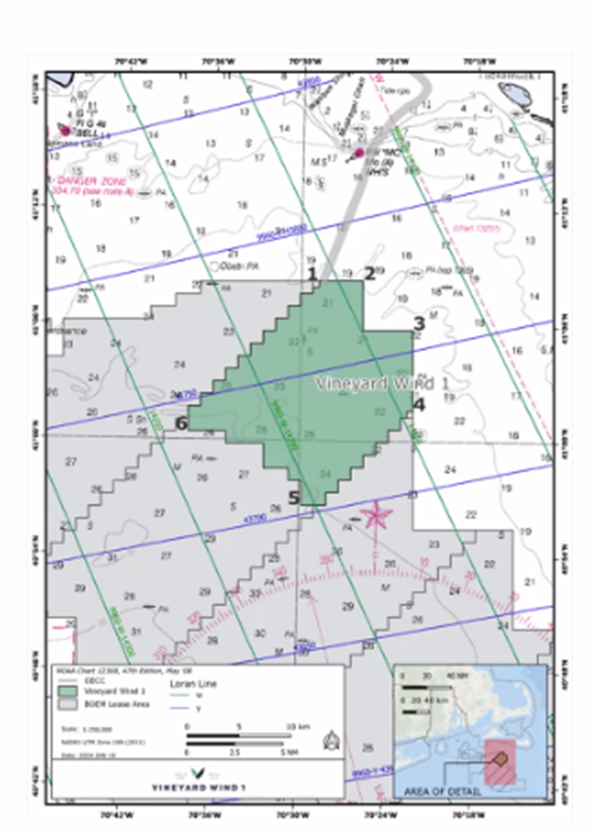Massachusetts Fisheries Innovation Fund, Solicitation 1 Now Closed
The Massachusetts Division of Marine Fisheries is now accepting applications to the initial solicitation of the Fisheries Innovation Fund (FIF). The purpose of the FIF is to “support programs and projects that ensure safe and profitable fishing continues” as offshore wind is developed in North Atlantic waters. This first solicitation seeks to award around $750,000, with preferred projects having budgets ranging from $25,000 to $300,000.
Empire Wind 1 (operated by Equinor) Fisheries Direct Compensation
The Empire Wind 1 Fisheries Compensation Program has been established to provide compensation to commercial and charter/for hire fishermen along with shoreside businesses that have been economically impacted by Empire Wind 1’s construction and operation activities. The compensation program is designed to minimize the administrative and documentation burden on fishers and to streamline the compensation process for impacted parties. The application period closes October 11, 2025.
Who is eligible?
Commercial and Charter/For-hire fishermen who;
- Have fished in the project area (or export cable corridor) for 3 years during the 2020-2024 period, and
- Currently hold a commercial permit.

Empire Wind farm area (pink) and offshore export cable corridor (blue line) in New York Bight and NMFS Statistical Area 612.
Shoreside services;
- located within 10 miles of New Bedford, Cape May or Point Pleasant, or having more than 20% of business associated with the project area, and
- having the majority of business revenues [50% of total revenue or more] documented in an up or downstream fishing support service (bait, ice, vessel repair, seafood dealers, etc.)
What documents are required to apply?
Commercial Fishermen and Charter for-hire
- Any federally and/or state approved trip level reporting information that establishes fishing activity within the Empire Wind 1 project area, such as the following: Landing reports (VTR, dealer reports, AIS data), VMS trip reports, federal dealer reports, dock sales receipts, Fishery observer or At Sea Monitor data, NOAA Cooperative Research Study Fleet data, Time-stamped chart plotter data/images, SAFIS data.
- A commercial permit.
- SAFIS data or equivalent demonstrating annual revenue from 2020 to 2024.
Shoreside Business
- A business license.
- Documentation demonstrating portion of revenue generated from upstream and downstream.
- A valid seafood dealer and/or processor permit, where applicable.
- Tax returns demonstrating annual revenue from 2020 to 2024.
What if I need help filing out my application?
The third party administrator, de maximis, will be available to provide support. Email: offshorewind@demaximis.com or Phone: 865-691-5052 If you have any questions, see the Compensation Program FAQs webpage, or contact Brad Schondelmeier.
Applying for Fisheries Compensatory Mitigation
Direct compensation eligibility applications are open for South Fork Wind. All fishers applying for direct compensation claims and payment must first complete and submit an eligibility application with each respective offshore wind developer’s third-party administrator.
South Fork Wind (operated by Ørsted)
South Fork Wind (owned by Ørsted) announced that their eligibility application for direct compensation has opened for commercial and recreational fishing vessels that have experienced economic impacts from construction and/or interruptions during operation from offshore wind vessels operating in the South Fork Wind Project Area. PKF O’Connor Davis (PKFOD), the third-party administrator for South Fork Wind, will be reviewing and processing eligibility and direct compensation claims. Eligibility will be evaluated by the third-party administrator with assistance from an independent fisheries advisor representing southern New England fisheries. For commercial vessels, information required for determining eligibility is Vessel Trip Report (VTR) data (if filed with NMFS), Massachusetts trip-level reporting data (electronic or paper), or tax returns for three years prior to construction or interruptions to fishing from offshore wind vessels operating with within the South Fork Wind Project Area. Optional documents to include consist of chart-plotter data within the South Fork Wind area, logbooks, vessel monitoring system (VMS) or observer program data relevant to your vessel. For for-hire party/charter boat vessels, required documentation includes eTRIPS Desktop or Mobile trip data submitted to NMFS for three years prior construction or interruptions to fishing from offshore wind vessels operating with within the South Fork Wind Project Area. Optional documentation for-hire vessels include other electronic information, such as chart-plotter data or logbooks. All applicants (for-hire and commercial) will also need to provide proof of either Massachusetts residency or demonstrate the vessel’s homeport is in Massachusetts. A map of the South Fork Wind Project Area is provided below.
Ørsted also has a Navigational Enhancement and Training Program (NETP) that offers vouchers for professional training, pulse compression radar systems, and new or upgraded Automatic Identification Systems (AIS) transceivers for eligible MA commercial and for-hire fisherman. Currently, eligibility for the NETP is contingent upon eligibility for fisheries direct compensation. While Ørsted funds and chairs the NETP program, claim eligibility is administered through the third-party administrator (PKFOD) and therefore, applicants must first submit an eligibility application (MA fisheries direct compensation program eligibility application). Voucher limits towards purchasing and installation of pre-approved equipment for navigation equipment for commercial vessels (US Coast Guard inspected) is $10,000 and $5,000 for for-hire vessels. For training, vessel owners may nominate two crew members for professional mariner training at a preapproved training facility (up to $1,000 vouchers each for crew members).
Find more information and eligibility applications on the direct compensation process.
Where to send South Fork Wind Eligibility Application
MA fisheries direct compensation program eligibility application.
Email address to send eligibility and claim applications: SouthForkFisheriesClaims@pkfod.com
Contact information for third-party administrator (PKFOD)
PKFOD Phone: (781) 937-5737
General Claims Email: SouthForkFisheriesClaims@pkfod.com
- Beth da Silva (CPA, CFF)- edasilva@pkfod.com
- Tom Pannell (CPA,CFF)- tpannell@pkfod.com
Where to send direct compensation claims for South Fork Wind (must first receive confirmation of eligibility)
Once confirmed eligible after submitting the eligibility application above, complete the claim application form.
Email address to claim applications: SouthForkFisheriesClaims@pkfod.com
Find more information about Ørsted’s Navigational Enhancement and Training Program.
For questions regarding the Ørsted Navigation Enhancement and Training Program (NETP), please contact the Ørsted fisheries liaisons:
- Ross Pearsall (ROSPE@orsted.com; +1-857-278-2442)
- John Mansolillo (JOMAN@orsted.com; +1-401-450-5467).
VINEYARD WIND 1 Compensation
The Vineyard Wind 1 Eligibility Period closed on June 17, 2024.
Get more information about this compensation.
For more information on the direct compensation process, please see the VW 1 compensatory program overview document.
If you need to contact NMFS for data requests pertaining to eligibility and compensation of programs above, see the contact list below:
Contacts for data requests:
- Logbook and fishing footprint data requests: NMFS.GAR.Data.Requests@noaa.gov
- VMS data requests: ole.helpdesk@noaa.gov
- Northeast Fisheries Observer Program data requests: chris.tholke@noaa.gov
- GARFO permit data requests: NMFS.GAR.Permits@noaa.gov
General guidance for requests:
- Be very clear about what you're requesting
- Include all the fundamental details:
- Contact information for the person requesting the data
- Permit number and vessel name for data requested
- What data you need (e.g., logbook landings, fishing revenue, permit issuance)
- Date range for the data (e.g., fishing or calendar years 2016-2022)
- Area the data applies (e.g., logbook data when fishing in the Vineyard Wind 1 lease area)
- Ensure you have access to historical data from previous owners
- Submit or reference existing written proof that a previous vessel/permit owner has given you permission to access their historic fishing data
- Make sure permissions include all years of your data request
- Identify expected data output (e.g., spreadsheet or map)
- Specify if data are needed by a certain date
Gear Loss Claims
Given that construction and operations of several offshore wind projects in Southern New England are underway, applications for fisheries gear loss/damage associated with offshore wind vessels, surveys, and structures are now open to claims submissions. Currently, Orsted (South Fork) and Vineyard Offshore (Vineyard Wind 1) gear claims applications are being accepted and can be directly submitted to developers. Instructions on how to fill out gear loss claim applications and eligibility criteria are available below.
Note: Gear loss claims are separate from direct fisheries economic loss compensation from direct losses/impacts arising from the construction and operation of offshore wind projects.
Orsted
- Orsted’s website for Mariners
- Gear Loss Claim Instructions
- Gear Loss Claim Application
- Notice of Appeal Application
Vineyard Wind
Vineyard Wind 1 Fisheries Liaison contacts for gear loss claims:
- Crista Bank, Fisheries Manager, Cell: 508-525-0421, Email: cbank@vineyardoffshore.com
- Jeannot Smith, Marine Liaison, Cell: 904-613-0134, Email: jsmith@vineyardoffshore.com
- Travis Lowery, Fisheries Liaison, Cell: 508-728-4529, Email: tlowery@vineyardoffshore.com
Public Engagement Opportunities
Port Hours
Offshore wind developers schedule monthly port hours to address any questions, comments, and feedback on the RI/MA Wind Energy Areas from the fishing community. Please review each wind energy project’s website for the up-to-date information on port hours. December port hours are to be determined.
Massachusetts Fisheries and Habitat Working Groups on Offshore Wind Energy
The Massachusetts Executive Offshore of Energy and Environmental Affairs and the Massachusetts Clean Energy Center convened two working groups for fisheries and marine habitat issues. The Fisheries Working Group on Offshore Wind Energy is comprised of commercial fishermen and representatives from different ports and sectors, recreational fishermen, scientists, and state and federal agencies. The Habitat Working Group on Offshore Wind Energy is comprised of scientists and technical experts from environmental organizations, academia, and state and federal agencies. Input from the working groups has directly resulted in accommodations to avoid important marine habitat, fishing grounds, and marine commerce routes in the designation of the wind energy lease areas. Working group meetings are generally convened at certain benchmark points in the wind energy commercial leasing process and are open to the public. For more information on past and upcoming meetings, visit the Fisheries Working Group on Offshore Wind Energy and Habitat Working Group on Offshore Wind Energy webpages.
Projects in Southern New England and DMF Engagement
The aim of this section is to inform fishermen, particularly from the Commonwealth of Massachusetts, of the status of all active and proposed offshore wind energy projects in the Southern New England area and provide information on upcoming engagement opportunities. For more information on RI/MA offshore wind construction updates, port hours, fisheries liaison contact information, and DMF comment letters, please click on the link titled “Marine and Fisheries Resources for Southern New England Offshore Wind Energy Project Documents” for construction updates and below.
Mariner and Fisheries Resources for Southern New England Offshore Wind Project Updates.
A map view that includes the status of offshore wind development in the U.S. Northeast Atlantic is availableand maintained by the Massachusetts Office of Coastal Zone Management.
The WATERFRONT app was developed in 2023 by Ithaca Clean Energy and provides up-to-date construction activities for offshore wind projects. WATERFRONT also provides real-time mariner updates, two-way communication with fishermen and offshore wind developers/vessels, and allows you to pin the location of your gear with the option of sharing with marine stakeholders.
Additional Resources
Planning and Leasing Activities in the Gulf of Maine
On October 20, BOEM released the draft Wind Energy Area (WEA) for the Gulf of Maine (Figure 1). The draft area encompasses a total area of 3,519,067 acres (a 64.11% reduction of the Call Area). The draft WEA has a combine capacity of over 40 Gigawatts (assuming a power density of 3 megawatts per sq. km). All areas currently identified in the draft WEA are deeper than 120m and at least 20nm offshore. Given the depth of the draft WEA, all potential offshore wind development will likely consist of floating technology. BOEM will finalize the WEA in the Gulf of Maine by February 2024 following request for comments (due on November 20). DMF has collaborated with the MA Office of Coastal Zone Management (CZM) and other EEA departments to draft a joint EEA comment letter to BOEM outlining areas and conflicts of most concern. The EEA comment letter provided input received from the Massachusetts fishing industry across several workshops and meetings, as well as subject matter experts from EEA agencies and offices. Once the WEAs are finalized, engagement and commenting opportunities will be available during the formation of bidding credits, lease stipulations, and lease characteristics. To learn more about the Commonwealth’s role in the Gulf of Maine planning process, visit CZM offshore wind.
Additional Resources
-
Open PDF file, 1 MB, EEA Comments to BOEM on RFI (English, PDF 1 MB)
Fisheries Mitigation in Southern New England
Under the Massachusetts Office of Coastal Zone Management (CZM) Federal Consistency Review process, the Commonwealth of Massachusetts has negotiated mitigation packages for commercial and recreational fishers impacted by the construction and operation of commercial-scale offshore wind projects. At this time, the Massachusetts Executive Office of Energy and Environmental Affairs (EEA) has entered into mitigation agreements with Vineyard Wind, LLC, South Fork Wind, LLC, New England Wind LLC, and Sunrise Wind LLC. These agreements are the result of extensive mitigation negotiations conducted between CZM, DMF, the EEA Fisheries Working Group on Offshore Wind, and project developers. All of the CZM consistency statements are available.
The Vineyard Wind Fisheries Innovation Fund was established under the Memorandum of Agreement between EEA and Vineyard Wind, LLC. The purpose of the Fund is to support programs and projects that ensure safe and profitable fishing continue as Vineyard Wind 1 and future offshore wind projects are developed in Northern Atlantic waters. The DMF Director chairs the Offshore Wind Fisheries Research, Innovation, and Science Advisory Panel to review and approve expenditures from the Vineyard Wind Fisheries Innovation Expendable Trust. See the below meeting materials and summaries from Fisheries Innovation Fund Advisory Panel meetings:
Offshore Wind and Fisheries Habitat Publications
- Offshore Wind and the Fishing Industry, 2020
- Recommended Fisheries Studies for Offshore Wind Development, 2019
- Management Objectives and Research Priorities for Offshore Wind and Fisheries, 2018
The Regional Wildlife Science Collaborative for Offshore Wind (RWSC) was cooperatively established and is led by federal agencies, states, NGOs, and the offshore wind industry to support research and monitoring on wildlife and offshore wind. The RWSC Science Plan was published on January 25, 2024 and was established to identify knowledge gaps and promote research on wildlife interactions with offshore wind. To learn more about RWSC activities, visit the RWSC webpage.
External Resources
BOEM is responsible for offshore renewable energy development in federal waters. To learn more about the status of activity pertaining to offshore renewable energy development in the different states, visit BOEM’s State Activities webpage.
NOAA Fisheries is the lead federal agency charged with stewardship of marine life. Offshore wind development on the Outer Continental Shelf affects NOAA Trust Resources including fisheries, protected species, seabirds, and marine habitats. To learn more about NOAA Fisheries’ role in offshore wind development, visit the Offshore Wind Energy Development in New England/Mid-Atlantic Waters webpage.
The Mid-Atlantic and New England Fishery Management Councils, working with NOAA Fisheries, collaboratively developed a webpage to provide information and resources that may be relevant to offshore wind energy development and fisheries. For more information on the Councils’ involvement in, and comments on, wind energy development activities, visit the Offshore Wind in the Northeast Region webpage.
The Responsible Offshore Science Alliance (ROSA) is a nonprofit organization that seeks to advance regional research and monitoring of fisheries and offshore wind interactions through collaboration and cooperation. For more information about ROSA’s mission, administration, and resources, visit the ROSA Science webpage.
The Regional Wildlife Science Collaborative for Offshore Wind (RWSC) was cooperatively established and is led by federal agencies, states, NGOs, and the offshore wind industry to support research and monitoring on wildlife and offshore wind. To learn more about RWSC activities, visit the RWSC webpage.
The Responsible Offshore Development Alliance (RODA) is a nonprofit organization that seeks to directly collaborate with federal agencies, regional fisheries management councils, states, offshore developers, scientific experts, non-profits, fisheries-driven groups, and others to coordinate science and policy approaches to managing offshore wind development of the Outer Continental Shelf that aims to minimize conflicts with current existing traditional and historical fishing. For more information about RODA’s mission and their ongoing activities, visit the RODA webpage.
The Northeast Ocean Data portal provides updates on the status of offshore wind projects and provides interactive maps of each lease area where a project is located. The Northeast Ocean Data Portal is operated by the Northeast Regional Ocean Council. For more information, visit the Northeast Ocean Data Portal Webpage.
Published in 2023 by NOAA Fisheries, BOEM, and RODA, the Synthesis of the Science (SoS) report synthesizes and compiled current and past research on the interactions of offshore wind, fisheries, and marine ecosystems across five topics. The topics identified for consideration in relations to offshore wind: ecosystem effects, fisheries socioeconomics, fisheries management and data collection, methods and approaches, and regional science planning. Additionally, SoS facilitates the current identification of knowledge gaps of offshore wind science. You can download the SoS report.
For more information on how state agencies and working groups along the Atlantic coast are engaging in offshore wind development on the Outer Continental Shelf, visit the following webpages:
- Maine Governor’s Energy Office - Offshore Wind
- New Hampshire Department of Energy - Office of Offshore Wind Industry Development and Energy Innovation
- Rhode Island Office of Energy Resources - Wind
- Rhode Island Department of Environmental Management - Offshore Wind
- Rhode Island Coastal Resources Management Council – Wind Energy
- Connecticut Department of Energy and Environmental Protection – Renewable Energy
- New York State Energy Research and Development Authority (NYSERDA) - Offshore Wind
- New York State Fisheries Technical Working Group (F-TWG)
- New Jersey Board of Public Utilities – Offshore Wind
- New Jersey Department of Environmental Protection – Offshore Wind
- Delaware Department of Natural Resources and Environmental Control - Offshore Wind Working Group
- Maryland Energy Administration – Offshore Wind Energy in Maryland
- Virginia Energy – Virginia Offshore Wind
- North Carolina Department of Environmental Quality – Offshore Energy

